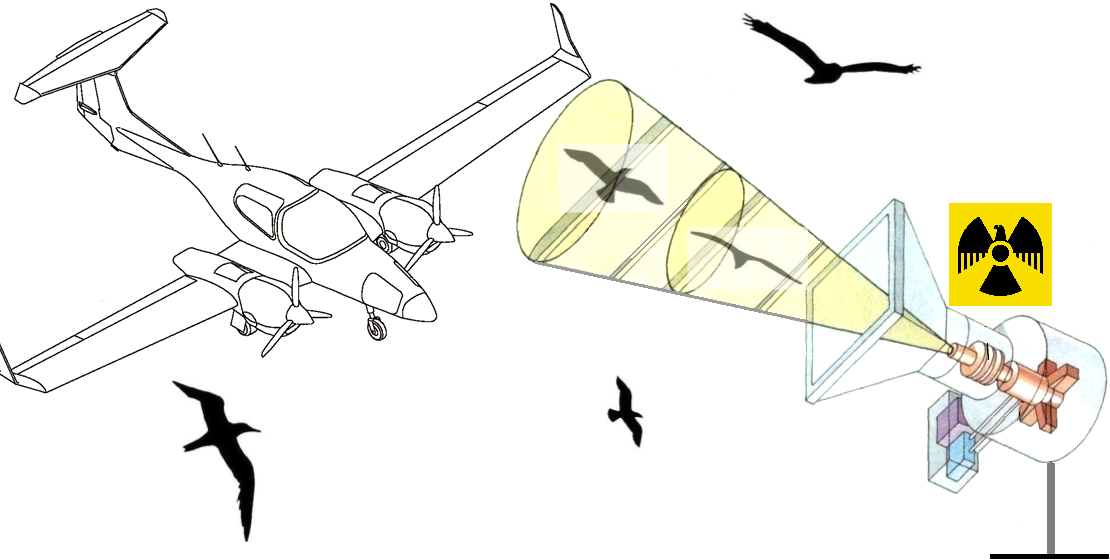Devising an alternative technique to manufacture a radioisotope source of 60Co for irradiation device to ensure ornithological safety of aircraft flights
DOI:
https://doi.org/10.15587/1729-4061.2023.290102Keywords:
aviation ornithology, civil aviation, ionizing radiation, radionuclide source, radiation doseAbstract
This paper reports an alternative technique for producing a source of hard gamma radiation with the 60Со isotope for the proposed device for radioactive irradiation of birds, which is also innovative in providing for ornithological aircraft flight safety. However, the high cost of producing a 60Со radionuclide source with activity sufficient to irradiate bird pests with a lethal or sterilizing dose poses a serious challenge. A solution to the problem of reducing the cost of a 60Со radionuclide source can be an alternative technique of its production outside the reactor.
The results are characterized by the following features and distinctive peculiarities that make it possible to solve the problem under study:
– an irradiation device with the radioactive isotope 60Со causes a lethal or sterilizing effect. This is much more effective in ensuring ornithological safety of aircraft flights compared to known methods of scaring away birds of prey, but is harmless to humans;
– the production of 60Со radionuclide for the irradiation installation is carried out by thermal diffusion heating, which significantly reduces the cost of the source compared to the well-known methods of its production in a reactor and accelerator.
The results obtained could find practical application in the field of civil aviation for ornithological flight safety, subject to compliance with national and international legislation. In addition, the proposed technique of manufacturing a 60Со radionuclide source, in addition to aviation ornithology, may find application in other sectors of industry, economics, and agriculture
References
- Juračka, J., Chlebek, J., Hodaň, V. (2021). Bird strike as a threat to aviation safety. Transportation Research Procedia, 59, 281–291. doi: https://doi.org/10.1016/j.trpro.2021.11.120
- Akzigitov, R., Kuznetsov, E., Musonov, V., Timokhovich, A. (2023). Ensuring the Safety of Aircraft Flights in Ornithological Terms. Transportation Research Procedia, 68, 566–572. doi: https://doi.org/10.1016/j.trpro.2023.02.077
- Kassenov, K.., Kim, D.S., Zhumagulova, R. Е. (2019). Some results and perspectives of the application of radiation treatment of agricultural products. Research, results, 3 (83), 354–360. Available at: https://journal.kaznaru.edu.kz/index.php/research/issue/view/7/5
- Belko, A. V., Dobratulin, K. S., Kuznetsov, A. V. (2021). Classification of plumage images for identifying bird species. Computer Optics, 45 (5). doi: https://doi.org/10.18287/2412-6179-co-836
- Judaibi, A., Soliman, A. Y. (2022). Simulation of cobalt-60 production in research reactors using OpenMC Monte Carlo code. Kerntechnik, 87 (2), 230–236. doi: https://doi.org/10.1515/kern-2021-1027
- Howard, R. H., Reichenberger, M. A., Urban-Klaehn, J. M., Peterson-Droogh, J. L., Brookman, J. V. et al. (2021). Overcoming challenges to support us resumption of high specific activity cobalt-60. Applied Radiation and Isotopes, 169, 109494. doi: https://doi.org/10.1016/j.apradiso.2020.109494
- Lyu, J., Ryu, E. H., Park, J. H. (2020). Innovative core design using cobalt-equipped bundles for cobalt-60 production in CANDU6 reactors. Annals of Nuclear Energy, 142, 107384. doi: https://doi.org/10.1016/j.anucene.2020.107384
- Delacroix, D., P. Guerre, J., Leblanc, P., Hickman, C. (2002). Radionuclide and radiation protection data handbook 2002. Radiation Protection Dosimetry, 98 (1), 1–168. doi: https://doi.org/10.1093/oxfordjournals.rpd.a006705
- Kudryashev, V. A., Kim, D. S. (2019). Determination of the total effective dose of external and internal exposure by different ionizing radiation sources. Radiation Protection Dosimetry, 187 (1), 129–137. doi: https://doi.org/10.1093/rpd/ncz170
- Kim, D. S. (2019). Methods of calculation of radiation protection for operational safety optimization at working with radionuclide photon radiation sources. Eurasian Journal of Physics and Functional Materials, 3 (4), 348–354. doi: https://doi.org/10.29317/ejpfm.2019030407
- Giuffrida, D. (2018). Source of Radiation Exposure in the Workplace: Nuclear, Medical and Industrial Sources. Physical Agents in the Environment and Workplace, 227–245. doi: https://doi.org/10.1201/b22231-11

Downloads
Published
How to Cite
Issue
Section
License
Copyright (c) 2023 Dmitriy Kim, Natalya Lutsenko

This work is licensed under a Creative Commons Attribution 4.0 International License.
The consolidation and conditions for the transfer of copyright (identification of authorship) is carried out in the License Agreement. In particular, the authors reserve the right to the authorship of their manuscript and transfer the first publication of this work to the journal under the terms of the Creative Commons CC BY license. At the same time, they have the right to conclude on their own additional agreements concerning the non-exclusive distribution of the work in the form in which it was published by this journal, but provided that the link to the first publication of the article in this journal is preserved.
A license agreement is a document in which the author warrants that he/she owns all copyright for the work (manuscript, article, etc.).
The authors, signing the License Agreement with TECHNOLOGY CENTER PC, have all rights to the further use of their work, provided that they link to our edition in which the work was published.
According to the terms of the License Agreement, the Publisher TECHNOLOGY CENTER PC does not take away your copyrights and receives permission from the authors to use and dissemination of the publication through the world's scientific resources (own electronic resources, scientometric databases, repositories, libraries, etc.).
In the absence of a signed License Agreement or in the absence of this agreement of identifiers allowing to identify the identity of the author, the editors have no right to work with the manuscript.
It is important to remember that there is another type of agreement between authors and publishers – when copyright is transferred from the authors to the publisher. In this case, the authors lose ownership of their work and may not use it in any way.









